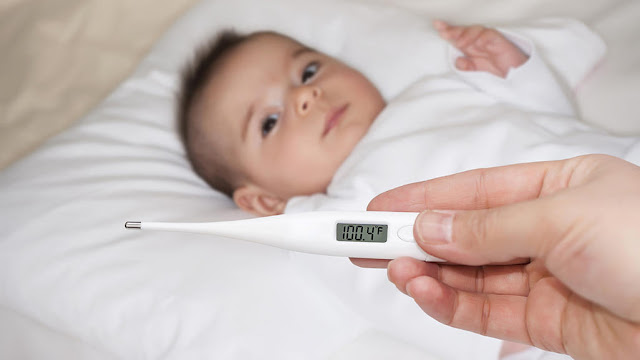Baby temperature: what's normal, how to treat a fever, and when to see a doctor
The first time that your baby gets sick with a temperature can be just as upsetting for you as it is for your baby. But being in the know about what is considered normal, when to be concerned and how you can lower their temperature can help you to be prepared.
Here, Dr Daniel Golshevsky, Chief Resident Medical Officer and pediatrician at the Royal Children's Hospital in Melbourne, answers parents' most common questions about baby temperatures.
What is considered the normal temperature range for a baby?
"The normal temperature for a baby is between 36°C and 37.5°C degrees, although this can vary according to the time it is taken, the method of checking and the device used," says Dr Golshevsky.
What is considered a high temperature for a baby?
Dr Golshevsky advises that babies under 3 months with a temperature of 38°C are considered to have a fever.
A temperature of 38.5°C indicates a fever in older babies and toddlers.
"A baby's history, signs and symptoms will often dictate whether a high temperature is of concern," explains Dr Golshevsky. "For example, they may have a high temperature because of excess clothing, wraps or blankets."
What is the best way to take a baby's temperature?
"While the most accurate measurement of body temperature is with a rectal thermometer, this can be uncomfortable and difficult to obtain," says Dr Golshevsky.
"For parents, the least distressing are those thermometers that are placed in the ear, rubbed across the forehead, or modern ones that use infrared technology and can be taken from a distance."
What can be some of the common reasons for a raised temperature in a baby?
"The most common cause for a short-lived, mild fever is a viral infection, and is a good sign that your child's immune system is fighting infection," advises Dr Golshevsky.
"It's important to note that fever is not an illness, but rather a symptom of the presence of an illness or inflammation. Therefore, it's important to not only treat the illness symptoms but also the underlying cause, if known."
Common causes of fever include colds and flu, ear and throat infections, and should be of no concern if they are occurring infrequently – up to once per month – and lasting no longer than 48 hours in duration.
While teething can also be a very common cause of raised temperatures in babies and can occur as early as a few months of age, it's unusual for this to cause a temperature over 38.5°C.
Other causes of raised temperature are chronic disease or overheating caused by sunburn or heat stroke.
Serious causes of fever include bacterial infection of the urine, lungs (pneumonia), blood and brain (meningitis).
Are there signs – other than taking a baby's temperature – that can indicate a raised temperature?
"Having a raised temperature can cause children to be uncomfortable and irritable, and they may complain of feeling cold when they are hot to touch," says Dr Golshevsky.
"A raised temperature can also cause flushed cheeks, painful muscles and joints, lack of appetite and sleepiness."
At what temperature is there cause for concern and what should a parent do?
Dr Golshevsky explains that the degree of a fever isn't necessarily related to the severity of the underlying cause, but advises that a fever in a baby under three months should always be reviewed by a doctor to determine the cause.
"Parents should be more concerned if their child show signs of neck stiffness or is bothered by light in their eyes, as these are possible signs of meningitis," he advises.
"Other signs to be concerned about are excessive vomiting, as this poses a risk of dehydration, the presence of a rash, breathing difficulties or excessive sleepiness."
Should the above symptoms appear in your baby, or if you are simply worried that the fever may represent something more serious, Dr Golshevsky recommends going to a doctor.
What are the ways in which a parent can reduce a baby's temperature?
"Small sips of clear fluid will help prevent dehydration and simple paracetamol or ibuprofen will help alleviate some of the symptoms," says Dr Golshevsky.
"However, reducing the temperature will not help your child fight an infection – it will only make them more comfortable."
In addition to this, Dr Golshevsky recommends removing excessive clothing while being careful not to make a child too cold, and using a damp cloth to pat their forehead and neck.
It is not recommended to put a child in a cold bath, sponge them down or fan them in any way.
More related blogs on baby:


Comments
Post a Comment